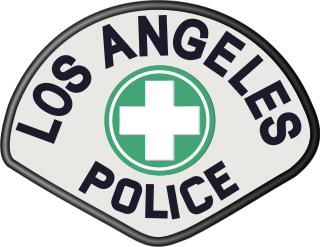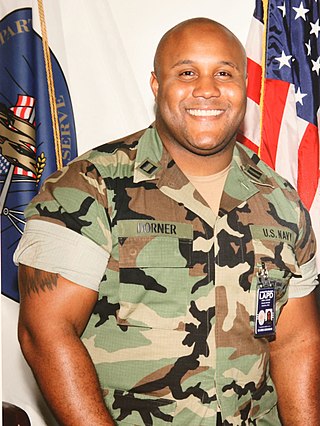Related Research Articles

The Los Angeles Police Department (LAPD), officially known as the City of Los Angeles Police Department, is the primary law enforcement agency of Los Angeles, California, United States. With 8,832 officers and 3,000 civilian staff, it is the third-largest municipal police department in the United States, after the New York City Police Department and the Chicago Police Department.

S.W.A.T. is a 2003 American action crime thriller film directed by Clark Johnson and written by David Ayer and David McKenna, with the story credited to Ron Mita and Jim McClain. Produced by Neal H. Moritz, it is based on the 1975 television series of the same name and stars Samuel L. Jackson, Colin Farrell, Michelle Rodriguez, LL Cool J, Josh Charles, Jeremy Renner, Brian Van Holt and Olivier Martinez. The plot follows Hondo (Jackson) and his SWAT team as they are tasked to escort an imprisoned drug kingpin/international fugitive to prison after he offers a $100 million reward to anyone who can break him out of police custody.

The Community Resources Against Street Hoodlums (CRASH) was a specialized gang intelligence unit of the Los Angeles Police Department (LAPD) tasked with combating gang-related crime between 1979 and 2000. The unit was established in the South Central district of Los Angeles, California, United States, to combat rising gang violence during the period. Each of the LAPD's 18 divisions had a CRASH unit assigned to it, whose primary goal was to suppress gang-related crimes in the city, which came about primarily from the increase in illegal drug trade.

Daryl Francis Gates was an American police officer who served as chief of the Los Angeles Police Department from 1978 to 1992. His length of tenure in this position was second only to that of William H. Parker. Gates is credited with the creation of SWAT teams alongside fellow Los Angeles Police Department (LAPD) officer John Nelson, who others claim was the originator of SWAT in 1965. Gates also co-founded the Drug Abuse Resistance Education program.

The Rampart scandal was a police corruption scandal which unfolded in Los Angeles, California, United States, during the late 1990s and early 2000s. The scandal concerned widespread criminal activity within the Community Resources Against Street Hoodlums (CRASH) anti-gang unit of the Los Angeles Police Department's Rampart Division. More than 70 police officers were initially implicated in various forms of misconduct, including unprovoked shootings and beatings, planting of false evidence, stealing and dealing narcotics, bank robbery, perjury and cover-ups thereof.

The Rampart Division of the Los Angeles Police Department (LAPD) serves communities to the west of Downtown Los Angeles (DTLA) including Silver Lake, Echo Park, Pico-Union and Westlake, all together designated as the Rampart patrol area. Its name is derived from Rampart Boulevard, one of the principal thoroughfares in its patrol area. The original station opened in 1966, located at 2710 West Temple Street. In 2008, the staff moved southeast to a newer facility located at 1401 West 6th Street. With 164,961 residents occupying a 5.4-square-mile (14 km2) area, Rampart is one of Los Angeles's most densely populated communities.
Frank Lyga is an American former police officer of the Los Angeles Police Department, who shot and killed officer Kevin Gaines. The resulting LAPD investigation of Kevin Gaines helped lead to the Rampart Scandal.

Christopher Jordan Dorner was a former officer of the Los Angeles Police Department (LAPD) who, beginning on February 3, 2013, committed a series of killings against the LAPD in Orange County, Los Angeles County, Riverside County and San Bernardino County in the U.S. state of California. The victims were law enforcement officers and the daughter of a retired police captain. Dorner killed four people and wounded three others. On February 12, Dorner killed himself after a shootout with the San Bernardino County Sheriff's Department deputies in the San Bernardino Mountains.

Ezell Ford, a 25-year-old African-American man, died from multiple gunshot wounds after being shot by Los Angeles Police Department (LAPD) officers in Florence, Los Angeles, California on August 11, 2014. In the weeks and months that followed, Ford's shooting triggered multiple demonstrations and a lawsuit by Ford's family claiming $75 million in damages.

The killing of Charley Leundeu Keunang, a 43-year-old Cameroonian national, occurred in Los Angeles, California, on March 1, 2015. He was shot by three Los Angeles Police Department officers.
On July 21, 2018, a hostage incident occurred at a Trader Joe's store in the Silver Lake neighborhood of Los Angeles. 28-year-old Gene Evin Atkins, armed and fleeing police, crashed into a utility pole and ran into the nearby store. He fired at two pursuing police officers during the pursuit and after the crash; the two officers returned fire in Atkins's direction, hitting and killing a store employee, Melyda Corado, and hitting Atkins in the left arm. After escaping into Trader Joe's, Atkins barricaded himself and the rest of the store's patrons and employees inside the store. By the end of the incident, Atkins was arrested for various criminal felonies.
References
- ↑ Ogbar, Jeffrey O. G. (January 1, 1999). "Slouching toward Bork: The Culture Wars and Self-Criticism in Hip-Hop Music". Journal of Black Studies. 30 (2): 164–183. doi:10.1177/002193479903000202. JSTOR 2645846. S2CID 145313509.
- 1 2 3 Feder-Haugabook, Ayala (October 21, 2017). "Eula Mae Love (1939-1979) •" . Retrieved April 8, 2021.
- 1 2 King, Jamilah (April 26, 2017). "Maxine Waters' battle against powerful white men began when Eula Love was murdered in 1979". Mic. Retrieved April 8, 2021.
- ↑ "Hopson v. City of Los Angeles (1983)". Justia Law. Justia. Retrieved June 18, 2016.
- ↑ Shaw, David (May 26, 1992). "Media Failed to Examine Alleged LAPD Abuses". The Los Angeles Times. Retrieved June 19, 2016.
- 1 2 Domanick, Joe (June 6, 1999). "A Shooting Reminiscent of the LAPD's Worst Days". Los Angeles Times. ISSN 0458-3035 . Retrieved June 16, 2016.
- 1 2 "On January 3, 1979, two officers fatally shot Eula Love, an African-American woman, in a confrontation that received widespread publicity." Christopher, Warren (1991). Report of the Independent Commission on the Los Angeles Police Department. DIANE Publishing. p. 194. ISBN 978-0-7881-4913-9.
- ↑ Scott, Allen John (1998). The City: Los Angeles and Urban Theory at the End of the Twentieth Century. University of California Press. p. 355. ISBN 978-0-520-21313-5.
- ↑ Los Angeles Board of Police Commissioners (1980). "Concerning the Shooting of Eula Love". Crime and Social Justice (14): 2–9. ISSN 0094-7571. JSTOR 29766096.
- ↑ ""Officer-Involved" Obfuscation". jacobinmag.com. Retrieved April 8, 2021.
- ↑ ""LA Rebellion Gidget Meets Hondo"" . Retrieved March 26, 2022.